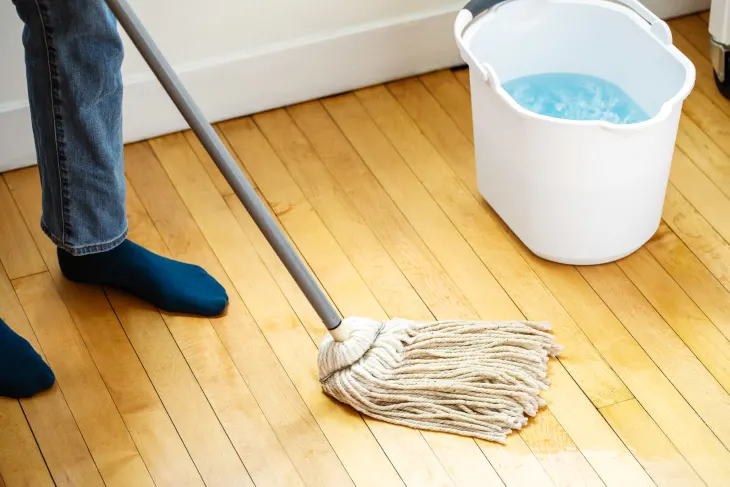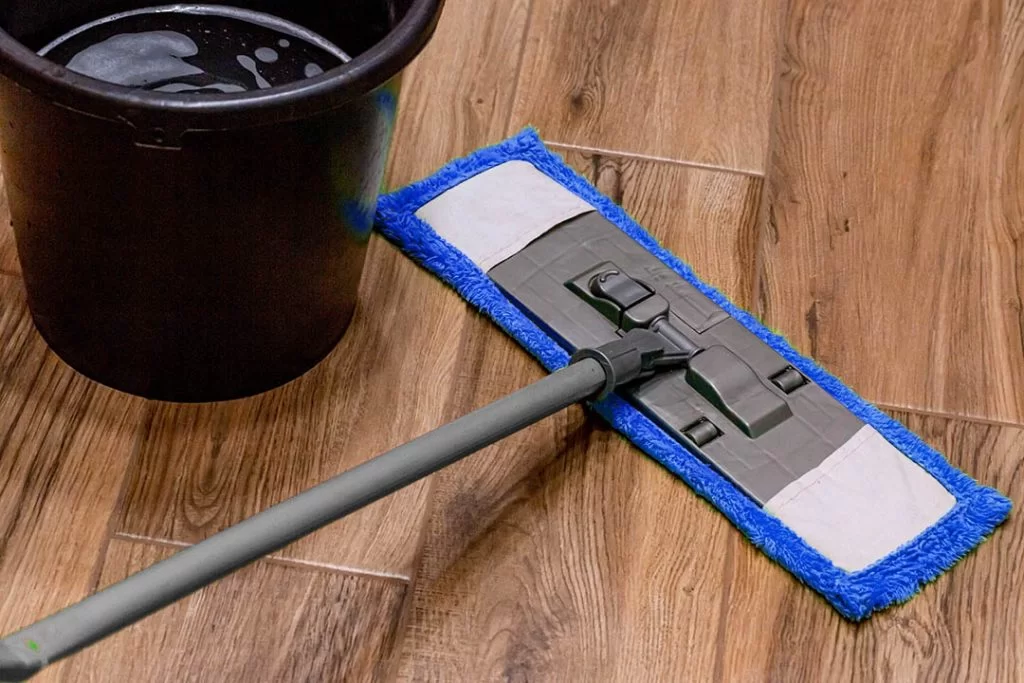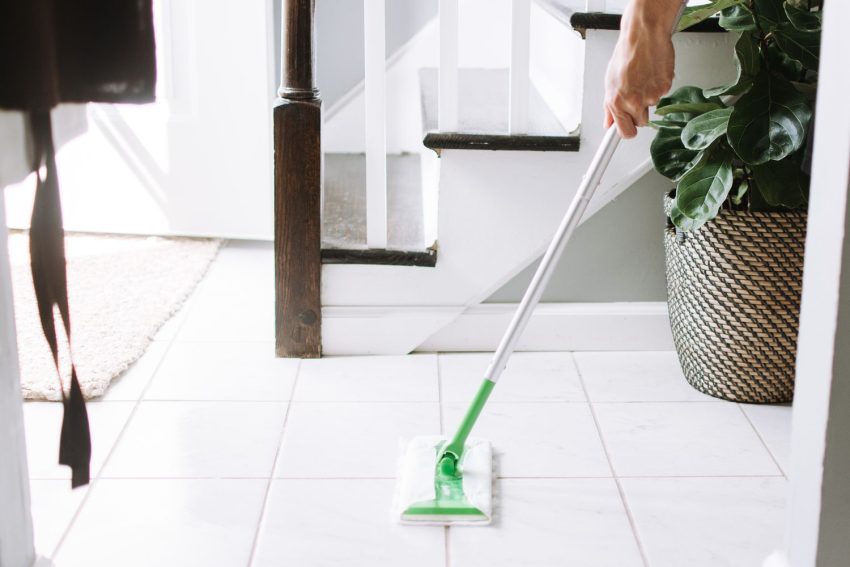Cleaning your floors is a regular household chore that often leaves us wondering if we can make do with what we have on hand. One common question that arises is whether it’s okay to use dish soap to mop floors. After all, dish soap is a versatile cleaning agent that works wonders on grease and grime in the kitchen, so why not extend its utility to our floors, right?
Yes, you can use dish soap to mop many types of floors, like ceramic tiles, porcelain, linoleum, vinyl, and marble. Dish soap contains surfactants that break down dirt and debris, making cleaning easier.
But remember, use it in moderation and choose the right floor type for dish soap mopping to get the best results.
In this article, we’ll discuss using dish soap for mopping your floors. We’ll look at the good and the not-so-good aspects and give you tips for doing it right.
Materials And Step-by-Step Guide

1. Gather the Necessary Materials
Before you start, make sure you have all the essential items ready for convenient mopping. The choice of materials is vital, as the wrong ones can cause issues. Here are the required materials:
- Dish Soap: Select a mild dish soap or dishwashing liquid suitable for your floor. Ensure it doesn’t contain harmful chemicals like bleach or phosphates.
- Mop: Choose the right mop for your needs. It could be a regular strong mop, a sponge mop, or a flat mop.
- Broom or Vacuum Cleaner: Use these to remove loose hair, dirt, and debris from the floor.
- Bucket of Warm Water: You’ll need this to prepare the dish soap solution and dip your mop.
2. Preparatory Steps
Before you begin mopping, it’s essential to clear the floor of any loose dirt, dust, debris, and pet hair. Sweep or vacuum the floor to ensure it’s clean. Additionally, temporarily move any furniture or obstructions from the floor to allow for easy mopping.
3. Prepare the Cleaning Solution
Now, it’s time to create the cleaning solution. Add 2 to 5 drops of liquid dish soap to a bucket of warm water. The correct soap-to-water ratio is crucial to prevent leaving a soapy residue on the floor. As a general guideline, you can use a maximum of half a cup of dish soap for every gallon (3.8 liters) of water. Then, using warm water helps the soap dissolve effectively without damaging the flooring.
4. Mop the Floor
Further, with the cleaning solution ready, wet it in the soapy mixture and wring out excess water. Ensure the mop is damp, as excessive water can harm the floor. Begin mopping from the farthest point in the room and work your way toward the exit. Use a figure-eight motion while maintaining even pressure throughout. This technique allows the mop to pick up large debris in one pass, saving time.
5. Rinse and Dry
In the end, once mopping is complete, rinse the floor with clean water to eliminate any soap residue. Dip it in clean water and wring out excess water, repeating the process multiple times until all soap residue is removed.
To prevent slip-and-fall accidents, it’s essential to thoroughly dry the floor. Use a clean, dry cloth or towel for effective drying, or let the floor air dry for approximately 30 minutes to one hour.
Note: Tips for Effective Mopping
- Change the mop water if it becomes visibly dirty during the cleaning process.
- Use a microfiber mop for a streak-free finish on hard floors.
- Regularly clean the mop head to prevent the transfer of dirt and residue.
Which Is More Effective: Regular Floor Cleaners or Dish Wash?
| Aspect | Dishwashing Soap | Regular Floor Cleaners |
| Cleaning Power | Effective on various stains and dirt | Formulated for specific floor types |
| Cost | Economical, often readily available | Prices vary, can be more expensive |
| Safety | Generally mild, safe for many surfaces | Specific formulations for safety |
| Residue | May leave residue if not rinsed properly | Designed to minimize residue |
| Fragrance | Mild or neutral scent | Various scents and options available |
| Versatility | Versatile for multiple floor types | Specialized for targeted use |
| Eco-Friendliness | Some dish soaps are environmentally friendly | Many floor cleaners are eco-conscious |
| Specific Stains | Effective on grease and common household stains | Formulated to target specific floor stains |
Alternative Floor Cleaning Solutions
Here are some alternatives to dish soap:
Dedicated Floor Cleaners:
- Many flooring manufacturers offer dedicated cleaners designed specifically for their flooring types. These products are tailored to provide optimal cleaning and protection.
Vinegar and Water:
- A solution of white vinegar and water (1:1 or 1:2 dilution with water) can effectively clean a variety of hard floors, including hardwood, laminate, and tile. Vinegar helps break down dirt and leaves a streak-free shine.
Baking Soda and Water:
- A paste made from baking soda and water can be used to clean and scrub surfaces with tough stains or grime. Baking soda is a mild abrasive that is safe for many types of floors.
Castile Soap:
- Castile soap is a mild, biodegradable soap that can be used to clean floors. It comes in various scents and is safe for most hard floors when diluted appropriately.
Lemon Juice and Water:
- Lemon juice mixed with water can help cut through grease and provide a pleasant citrus scent. It’s particularly effective on tile and linoleum floors.
Essential Oils:
- Add a few drops of essential oils like lavender, tea tree, or eucalyptus to your cleaning solution for a fresh scent and potential added antibacterial properties.
Commercial Eco-Friendly Cleaners:
- There are various eco-friendly and natural floor cleaners available in stores. Look for products with biodegradable and environmentally friendly ingredients.
Steam Mops:
- They use hot steam to clean and sanitize floors. They are effective on a variety of surfaces and are chemical-free.
Homemade All-Purpose Cleaner:
- Create an all-purpose cleaner by mixing water, white vinegar, and a small amount of dish soap or Castile soap. This can be used on many different floor types.
Microfiber Mops:
- They are effective at trapping and removing dust and dirt without the need for chemical cleaners. They work well with water or very dilute cleaning solutions.
Advice and Safety Measures for Using Dish Soap to Safely Mop Floors
- To prevent spreading dirt, change the mop water regularly during the cleaning process.
- Opt for a microfiber mop as it cleans more efficiently, effectively sweeping away dirt and grime.
- Using too much can lead to a slippery floor and leave a residue. This residue can be a safety hazard, causing accidental slips. Use dish soap sparingly.
- For stubborn grime or debris, consider spraying the cleaning solution directly on the stain and allowing it to sit for a minute before mopping. Repeat this process until the floor is clean.
- Ensure the safety of your children and pets by keeping them away from the wet floor during and after mopping.
- To prevent slips and falls, wear non-slip shoes while mopping. If needed, use rubber gloves for added protection.
- Make sure the room is well-ventilated to help the floor dry faster and avoid moisture buildup.
- Be careful around electrical outlets and devices. Water and electricity don’t mix, so don’t mop near them. If water spills on electronics, unplug them right away.
- Have a plan for accidents. Keep a first-aid kit and cleaning supplies nearby in case of spills, falls, or mishaps.
Pros and Cons of Mopping Floors with Dishwashing Soap
Pros:
- It is designed to cut through grease and grime, making it effective at removing oily or greasy stains from floors.
- Generally more affordable than specialized floor cleaning products, providing a cost-effective option for regular floor cleaning.
- Dish soap is a common household item, readily available whenever you need to clean your floors.
- Typically do not contain toxic or corrosive chemicals, ensuring the safety of your children and pets.
- Some are formulated to be gentle on various surfaces, making them suitable for delicate floors like hardwood or laminate.
Cons:
- Improper rinsing can result in a sticky residue on the floors, attracting more dirt and dust over time.
- Certain soaps can leave a slippery film on the floor, increasing the risk of slips and falls, particularly on smooth surfaces like tiles or linoleum.
- Using dishwashing soap regularly on wood, natural stone, or waxed floors can lead to damage or discoloration over time.
Versatile Uses of Dish Soap for Cleaning
| Use | Description |
| Floor Mopping | Mix 1-2 tablespoons of dish soap with water for clean floors. Suitable for linoleum, vinyl, and ceramic tile. Avoid on wood floors. |
| Laundry Stain Removal | Gently rub dish soap into oil-based stains before washing. Effective on food-based oils and fine fabrics like silk and wool. |
| Cleaning Surfaces | Use a mild dish soap solution to clean countertops, baseboards, windowsills, and more. |
| Cleaning Appliances | Clean kitchen appliances like microwaves, toasters, ovens, and refrigerators with a solution of dish soap and water. |
| Cleaning Air Conditioner Filters | Soak the filter in warm water mixed with dish soap, scrub, rinse, and dry. |
| Washing Window Blinds | Use a mixture of dish soap and water to clean metal blinds blade-by-blade. |
| Cleaning Glass | Diluted dish soap can clean glass surfaces, especially on very dirty glass. |
| Degreasing Kitchen Cabinets | Mix dish soap in warm water to scrub kitchen cabinets and cut through grease buildup. |
| Outdoor Cleaning | Clean patio furniture, barbecue grills, and remove oil or grease stains on concrete using dish soap. |
| Cleaning Jewelry | Mix a tiny amount of dish soap with seltzer water to soak and clean dirty jewelry pieces. Use a soft toothbrush for grime removal. |
| Personal Grooming | Use dish soap as a substitute for shampoo and body soap. It’s mild and can serve for various cleaning needs. |
| Cleaning Hair Brushes/Combs | Soak in a solution of warm water and dish soap to remove oils and grooming products. |
| Carpet Stains | Create a dish soap solution to dab and remove carpet stains. Rinse with cold water and pat the area dry. |
When Not to Use Dish Soap and Alternative Cleaning Solutions

| When Not to Use Dish Soap | Reason | Alternatives |
| Your Hair | Strips natural oils and damages hair. | Sulfate-free shampoo. |
| Hardwood Floors | Leaves behind a film and may damage the finish. | Gentle cleanser for wood flooring. |
| Dishes in the Dishwasher | Lather clouds are bad for dishwashers. | Dishwasher-specific detergent like Finish. |
| Your Face | Removes protective oils from the skin. | Mild cleanser like Cetaphil. |
| Leather | Harsh on fine leather, may cause cracking. | Wipe with a damp cloth and use leather conditioner. |
| Your Dog | Too harsh for regular pet use, may dry out skin and coat. | Dog-specific shampoo. |
| Plants | Harsh on plants and not effective against pests. | True insecticidal soap for plant use. |
| Silk Clothing | May damage delicate silk fabrics. | Delicate fabric-specific formula. |
| Cast Iron Frying Pan | Removes the seasoned non-stick coating. | Use a scrubber or coarse salt with water. |
| Mirrors | Leaves streaks if not rinsed properly. | Glass cleaner formulated for mirrors. |
| Your Car | Strips protective coating and damages auto paint. | Car-specific cleanser like Meguiar’s Gold Class. |
FAQs
Q1: What is the best dish soap for mopping floors?
A1: Any mild dish soap or dishwashing liquid is suitable for mopping floors. If you’re looking for branded options check out Here
Q2: Why is my floor soapy after mopping?
A2: Using too much detergent or not properly diluting it can leave a soapy residue on the floor. Additionally, if you don’t rinse the mop thoroughly or use clean water for rinsing, the floor can become slippery and sticky.
Q3: What can I use if I have no floor cleaner?
A3: If you don’t have a specific floor cleaner, dish soap can be a good alternative. You can also create a vinegar solution by mixing equal parts of water and white vinegar in a bucket. Another option is to make a cleaning paste by mixing baking soda with a small amount of water and using it to clean the floor.
Q4: Can I use washing up liquid to mop the floor?
A4: Yes, washing up liquid or dish soap can be used for mopping the floor, provided it is diluted appropriately. It is effective for cleaning various floor types.
Q5: Can I mop wood floors with dish soap?
A5:Yes, While dish soap can be used on wood floors, it’s important to be cautious and not use excessive water, as it can damage wood. Ensure you mop wood floors sparingly and dry them promptly.
Q6: What detergent do you use to mop the floor?
A6: You can use mild dish soap or dishwashing liquid to mop the floor effectively. These products are readily available and work well for most floor types.
Q7: Can you mop the floor with vinegar or dish soap?
A7: Yes, you can use a vinegar and water solution or dish soap to mop the floor. Both are effective for cleaning and breaking down dirt and grime. Just be sure to follow proper dilution and rinsing to avoid residue buildup.
Final Words
In conclusion, using dish soap to mop floors can be a practical and effective cleaning solution for various floor types, including ceramic tiles, linoleum, vinyl, and more. Its ability to break down dirt and grime makes it a valuable option for regular cleaning tasks.
However, it’s essential to exercise moderation, choose the right type of floor, and ensure thorough rinsing to prevent residue buildup. While dish soap offers convenience and affordability, it’s also important to consider specialized floor cleaners for specific floor types and stains.

